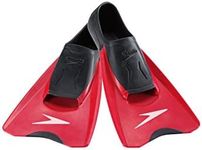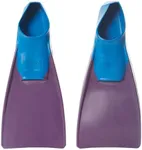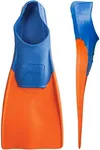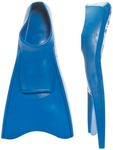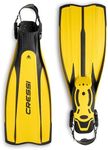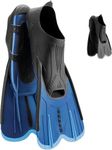Buying Guide for the Best Swimming Fins
Choosing the right swimming fins can significantly enhance your swimming experience, whether you're training, snorkeling, or just enjoying a swim. The right pair of fins can help improve your technique, increase your speed, and reduce fatigue. To find the best fit for you, it's important to understand the key specifications and how they align with your needs and preferences.Blade LengthBlade length refers to the length of the fin's blade. This spec is important because it affects the amount of propulsion you get from each kick. Short blades are ideal for swimmers looking to improve their kick technique and build leg strength, as they require more frequent kicks. Medium blades offer a balance between speed and technique, making them suitable for general training. Long blades provide maximum propulsion with each kick, making them great for snorkeling or leisurely swimming. Choose the blade length based on your swimming goals: short for training, medium for versatility, and long for relaxed swimming or snorkeling.
MaterialThe material of the fins affects their flexibility, durability, and comfort. Common materials include rubber, silicone, and composite materials. Rubber fins are durable and provide a good balance of flexibility and stiffness, making them suitable for most swimmers. Silicone fins are softer and more comfortable, reducing the risk of blisters, but they may not be as durable as rubber. Composite materials can offer a mix of properties, providing both flexibility and strength. Consider your comfort and how often you plan to use the fins when choosing the material. If you swim frequently, durability might be a priority, whereas occasional swimmers might prioritize comfort.
Foot PocketThe foot pocket is where your foot goes into the fin. This spec is crucial for comfort and fit. Closed-heel foot pockets provide a snug fit and are generally more comfortable for longer swims, making them ideal for training and snorkeling. Open-heel foot pockets are adjustable and can be worn with booties, offering more versatility and a secure fit, which is great for diving or swimming in colder waters. Choose a foot pocket based on your comfort preference and the type of swimming you'll be doing. If you need a secure fit and versatility, go for open-heel; for comfort and ease, closed-heel is the way to go.
StiffnessStiffness refers to how rigid or flexible the fin blade is. This spec is important because it affects the effort required to kick and the propulsion generated. Soft fins are more flexible and require less effort to kick, making them suitable for beginners or those looking for a more relaxed swim. Medium stiffness fins offer a balance between effort and propulsion, making them ideal for general training. Stiff fins provide maximum propulsion but require more effort to kick, making them suitable for advanced swimmers or those looking to build leg strength. Choose the stiffness based on your swimming level and goals: soft for ease, medium for balance, and stiff for power.
BuoyancyBuoyancy refers to the fin's ability to float in water. This spec is important because it can affect your body position and swimming technique. Neutral buoyancy fins neither sink nor float, helping maintain a natural body position in the water, which is ideal for training. Positive buoyancy fins float, which can help keep your legs higher in the water, reducing drag and improving speed, making them suitable for competitive swimmers. Negative buoyancy fins sink, which can help with underwater swimming and diving. Choose the buoyancy based on your swimming style and goals: neutral for training, positive for speed, and negative for diving.

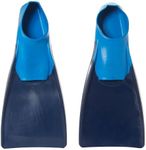
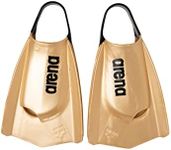



![Cressi Agua (blue) [41/42]](https://images-proxy.bestreviews.guide/2YkGh8Eh4cHqI8_PFqCqW8Su_Ac=/0x150/https://m.media-amazon.com/images/I/41A7VnKlBhL._AC_CX679_.jpg)
